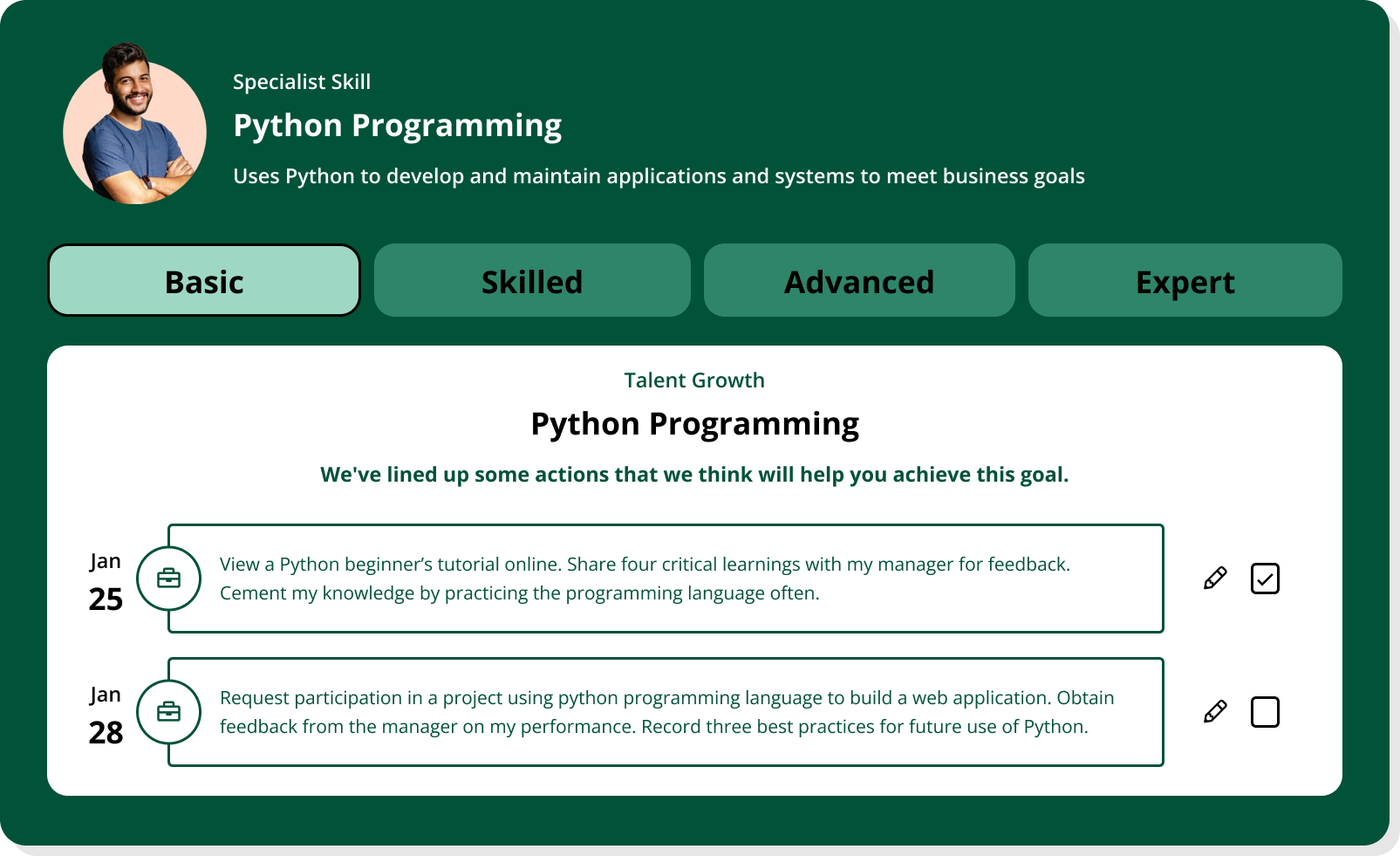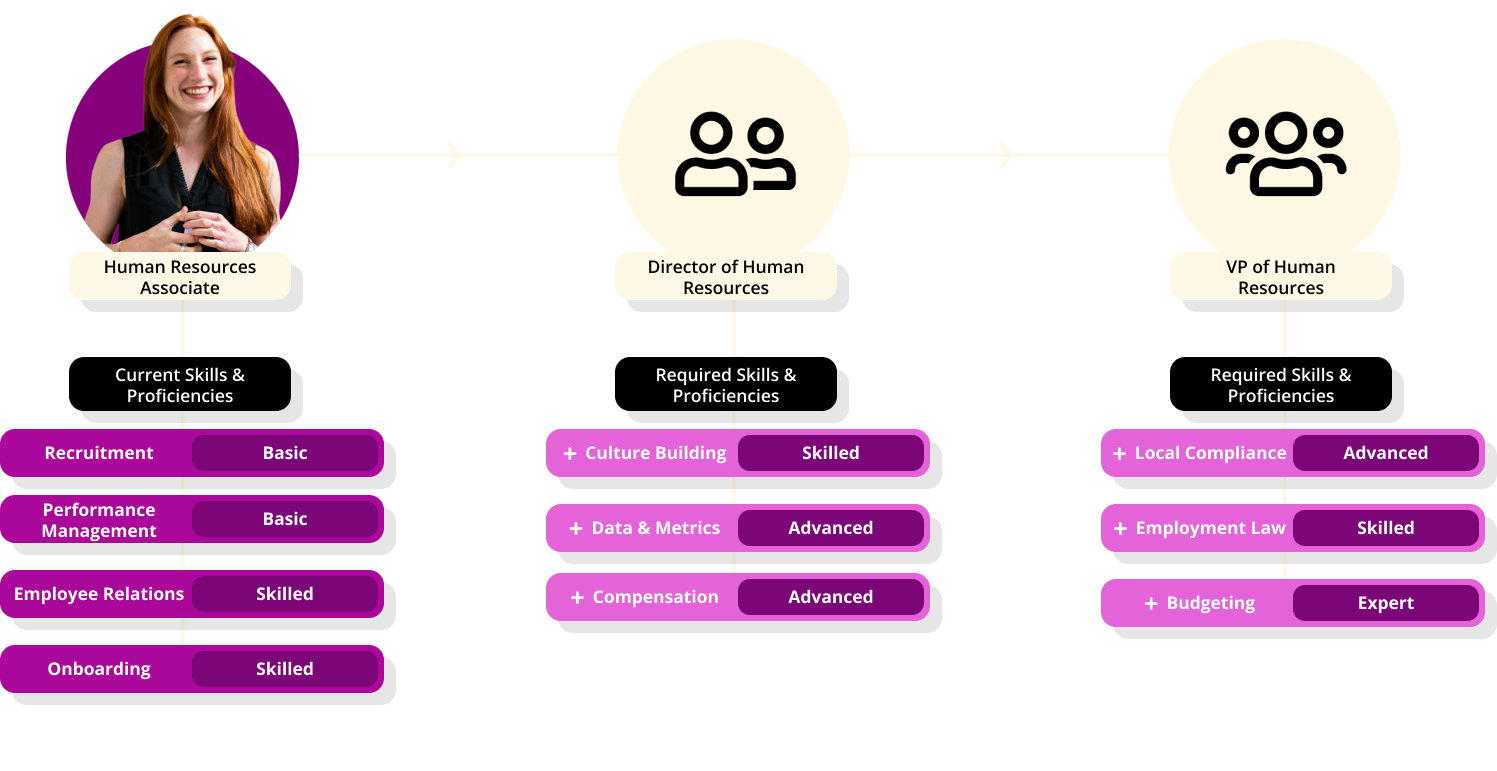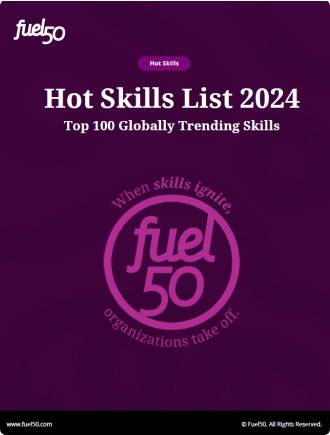In September, we launched our Skill Inventory feature, a powerful tool designed to help organizations seamlessly manage and govern their workforce capabilities.
As we engaged with industry leaders, HR professionals, and talent strategists, one key observation emerged: Many were confusing skills inventory with skills architecture.
The former serves as a structured database of skills within an organization; it’s not a standalone solution for workforce transformation. Without a well-defined skills architecture and intelligence framework, an inventory remains static and lacks the strategic insights needed to drive tangible business outcomes.
In this article, we clarify what a skills inventory is, why it’s essential, and how it fits into the broader landscape of talent management. We also provide a step-by-step guide on how to create one, explore its strategic value, and explain why inventory alone is insufficient without a supporting intelligence system.
What is a skills inventory?
A skills inventory is a structured database that records employees’ competencies, qualifications, and expertise. It serves as a central repository to help HR leaders and managers assess skills gaps, plan workforce development, and make data-driven talent decisions.
A well-maintained inventory enables organizations to:
- Identify skill gaps and training needs.
- Enhance workforce planning and internal mobility.
- Improve recruitment by matching candidates to role requirements.
- Facilitate succession planning and career development.
- Optimize project assignments based on employee strengths.
A skills inventory works best un-isolated
By itself, a skills inventory is incomplete. To derive measurable value, organizations must integrate it with skills intelligence (real-time analysis of skill trends, gaps, and forecasting) and a skills architecture (a structured framework for classifying and managing skills within an enterprise). Here’s how they work together:
- Skills Inventory: The database captures employee skills, certifications, and proficiency levels.
- Skills Intelligence: Analytical tools assess workforce capabilities, predict skill shortages, and recommend interventions.
- Skills Architecture: The structured framework ensures skills are categorized meaningfully to avoid duplication and misalignment.
Without this interoperability, a skills inventory becomes a static list that lacks the adaptability and strategic impact necessary in today’s workforce landscape.
The importance of a skills inventory
A skills inventory provides actionable insights that empower businesses to:
- Prioritize in-demand skills for future growth: A dynamic skills inventory helps businesses identify emerging and critical skills, ensuring they invest in talent that aligns with future business strategies. Without an up-to-date skills inventory, companies risk stagnation and losing ground to competitors who proactively manage their workforce capabilities.
- Leverage market insights to stay competitive: A skills inventory must be cross-referenced with external labor market data to provide actionable business intelligence. By analyzing trends in job postings, salary benchmarks, and competitor skills demand, organizations can anticipate industry shifts and adapt before skill shortages impact productivity.
- Govern skills ontology effectively with AI-driven solutions: A standalone skills inventory is static without governance. Companies need a structured skills architecture to categorize skills by relevance, adjacency, and proficiency. AI-driven tools can enhance this by continuously updating skill relationships, identifying redundancies, and ensuring the inventory reflects real-world job functions.
- Enhance employee engagement by offering clear career pathways: Employees stay when they see growth opportunities. A skills inventory alone doesn’t create career mobility though; it must be integrated with skills intelligence—insights that show employees how to bridge skill gaps and progress in their careers. Organizations that connect their skills inventory to personalized learning and internal mobility platforms create a system that nurtures talent and reduces attrition.
How to create a skills inventory?
You can construct a skills inventory through software solutions or an internal, manual approach. If you’re looking for an efficient, AI-driven solution, you can leverage Fuel50’s Skill Inventory, which automates the entire process, from skills tracking to generating market insights.
However, for companies that prefer to build their own system, the process requires a structured and disciplined approach.
Before diving into data collection, the first and most critical step is to ensure organizational readiness and alignment. Without a clear purpose, a skills inventory is merely another administrative exercise that won’t translate into strategic value.
You must define why you are building the inventory—whether for workforce planning, talent mobility, or reskilling initiatives—and secure leadership buy-in. Executive support is imperative to properly utilize a skills inventory across all departments. Governance is equally crucial; clear policies must be in place to determine how skills data is collected, updated, and validated. This ensures consistency and prevents the inventory from becoming a chaotic and unreliable dataset.
Once alignment is established, the next step is to identify key skills and competencies relevant to the business. Beyond simply listing obvious technical skills, organizations must also consider soft skills, emerging capabilities, and industry-specific expertise.
A financial services company, for example, may need expertise in data analytics, compliance, and cybersecurity, while a manufacturing firm might prioritize supply chain optimization, automation, and sustainability skills. External benchmarking against competitors and industry reports ensures the identified skills remain relevant in a rapidly evolving market.
With a clear skill framework in place, the next phase is data collection.
Relying on a single source of input is ineffective; skills must be validated through multiple channels. Self-assessments allow employees to report their skills, but these must be cross verified with managerial evaluations, performance reviews, and HR records to ensure accuracy.
Once data is collected, it’s essential to structure and categorize it effectively. Standardizing proficiency levels—for example, using a scale from “beginner” to “expert”—supports consistency across the organization.
Skills should also be tagged to specific roles to facilitate workforce planning and career mobility. Further, a well-structured skills database must account for adjacent and emerging skills so companies can anticipate future needs rather than just documenting current capabilities.
Now, you have a living skills inventory.
You must next implement a system that makes the data actionable. Your inventory should possess ready accessibility and usability, allowing both employees and managers to update, track, and analyze skills in real time.
The system should also integrate into learning and development platforms to connect skills data with personalized training recommendations. This integration is critical for an active skills inventory that drives meaningful workforce transformation.
You have a skills inventory — now what?
Having a skills inventory is only the beginning. To translate raw skills data into strategic workforce decisions, you must incorporate it into a well-structured skills architecture and intelligence framework.
Skills architecture ensures each skill is properly categorized, benchmarked, and mapped to roles, while skills intelligence leverages AI and analytics to uncover trends, predict future demands, and close critical gaps.
A robust skills intelligence system enables your organization to identify misalignments between their current workforce capabilities and future business needs.
By analyzing real-time labor market trends, you can proactively reskill employees before skills gaps become a liability. This additionally empowers HR leaders to optimize internal mobility so that talent is continuously matched with opportunities that align with both individual aspirations and business priorities.
Furthermore, with intelligence-driven insights, organizations can enhance workforce planning, reduce dependency on external hiring, and foster a culture of continuous learning and adaptability.
Use Fuel50’s talent marketplace and skill intelligence to unlock your workforce’s potential
Fuel50 provides an integrated solution that transforms a skills inventory into a strategic asset. By combining skills intelligence with a powerful talent marketplace, Fuel50 helps companies align workforce capabilities with business objectives, optimize employee growth, and enhance internal mobility.
Structure your workforce’s capabilities
Fuel50’s expert-driven skills ontology helps organizations go beyond collecting skills data to structure it in a way that makes sense for strategic workforce planning.

By defining skills with proficiency levels, career pathways, and adjacent capabilities, Fuel50 helps companies build a resilient and future-ready workforce. This allows HR leaders to maintain an up-to-date skills taxonomy that evolves with business needs, thus preventing redundancy and ensuring skills data remains actionable.
Identify gaps and future-proof the workforce

Fuel50’s AI-powered skills intelligence analyzes both internal workforce data and external labor market trends to identify skill gaps, emerging roles, and areas where reskilling is needed.
Instead of relying on outdated job descriptions, companies can leverage real-time insights to make informed talent decisions so employees continuously develop skills that drive both personal growth and business priorities.
Retain and grow talent
Fuel50’s talent marketplace fosters seamless internal mobility by matching employees to relevant career opportunities based on their skills, aspirations, and wider business needs.

This not only improves retention but also lowers recruitment costs by leveraging existing talent instead of seeking external hires. Employees gain visibility into career growth opportunities, while HR teams can proactively fill critical roles with internal candidates.
Strategically deploy talent
With Fuel50, organizations can skip reactive hiring and take a data-driven approach to workforce planning. By pinpointing where skills are concentrated and where gaps exist, HR leaders can make strategic talent deployment decisions, ensuring the right people are in the right roles at the right time. This slashes workforce inefficiencies, minimizes talent shortages, and improves overall business agility.
By adopting Fuel50’s talent marketplace and skills intelligence, your organization can upgrade its skills inventory from a static repository to a strategic advantage. This ensures skills data is not only collected but actively used to drive workforce decisions, close skill gaps, and create a culture of continuous growth and mobility.











